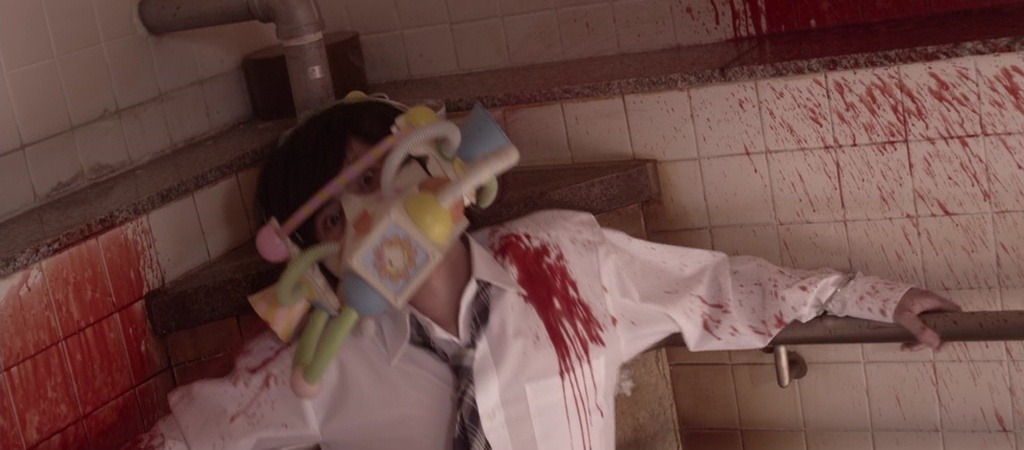
Even with such high emotional stakes both father and son are not treated as the integral they should be. Equally hampered is police officer Mitome (Kazuya Takahashi), whose son is heavily involved, defying orders to avoid this case due to his personal connection. Unfortunately his backstory isn’t as well developed or explored as it should have been considering the magnitude of the role he plays in the tale, a drawback of the film’s brisk 85 minute runtime. He is a difficult character to read as he appears in public to be a socially and perhaps mentally awkward yet he is clearly someone with a very devious and creative mind. That doesn’t make it right however, so beneath the crimson soaked bluster and unsettling violence we have your basic “eye for an eye” ethos taken to the extreme to make us think while we bring our lunch up!Ĭentral to the whole fiasco alongside Azusa is her classmate Shigeo Yuasa (Shuhei Nomura), a quiet gangly lad who seems oddly pleased with the results of Takai’s abduction and the subsequent deaths. Of course, the rationale of why justice is required is not revealed straight away and even then, the goal posts are shifted with each new piece of information, making the previously innocent guilty and the already guilty up to their necks in it.īy the end it all makes sense and even the twisted tag line “ No one deserves to live in this world” takes on a tragic new meaning to shed some light on this unusual brand of vigilante justice. Where the SAW influence arises is in the idea that justice is being dealt out to those entrapped in these fatal devices. The masked gang – their faces are obscured by the same sunflower design Takai cherished – set up their victims in timed explosive traps and the solution is to find the puzzle piece and complete the image within a fixed period. It is the latter which has earned Puzzle comparisons to the ingenious SAW series, although Korea’s Death Bell is arguably a closer companion piece, not in the least the school setting. You might view that as a spoiler but it is an inevitability given the nature of the story so Naito has to make the lead up worth our while, which he does with the piecemeal exposition and inventive set ups for the bloodshed. But why? Again we jump back to the weeks leading up to this fateful night to provide further insight into the convoluted and frankly twisted mess which lead to the mess where are at now and the mess which is still to come.Īnd a mess is exactly what this is – a huge unavoidable mess which has spiralled out of control and can only end in grim, bloody, senseless carnage, which of course it does. Takai and four male students disappeared that night, two of them resurfacing as victims of the next puzzle. Their failure has far-reaching consequences not just for Yasuda but everyone involved, although not in the way you might imagine.
#Pazuru 2014 free#
Yasuda (Kokone Sasaki) and instruct the others to collect puzzle pieces within a set time limit to free her.

A month later while the teachers and headmaster Takai (Ryuzo Tanaka ) work late a masked gang arrive, tie up pregnant teacher Ms. Jumping between flashbacks and present day, the film opens with one of the students Azusa Nakamura (Kaho) leaping off the roof, only to survive. Naito releases retrospective chunks of information and we are left to slot them together while trying to guess what will happen next. To summarise the story is a little difficult since the construction of the narrative is just as the title suggests – a puzzle. Ironically this is revealed to be a central theme of the story but it may be too obscured by the bloodsoaked façade and remorseless shocking events which unravel on screen. Then again we are hardly any better for wanting to watch this…

Indeed that particular film title rears its ugly head during the uncomfortable opening fifteen minutes which set up this perverse and discordant morality tale and even with this context in mind, it is still not that difficult to question the psychological stability of Yamada and Naito. Conversely, there are some which on paper sound like the onset of the apocalypse – case in point: Yusuke Yamada, the writer whose books inspired Sion Sono’s Tag and Eisuke Naito, director of the unpleasantly titled Let’s Make The Teacher Have A Miscarriage Club.

In the arts there are often fantasy combinations of separate talents which offer much excitement to the fans should they ever occur.


 0 kommentar(er)
0 kommentar(er)
